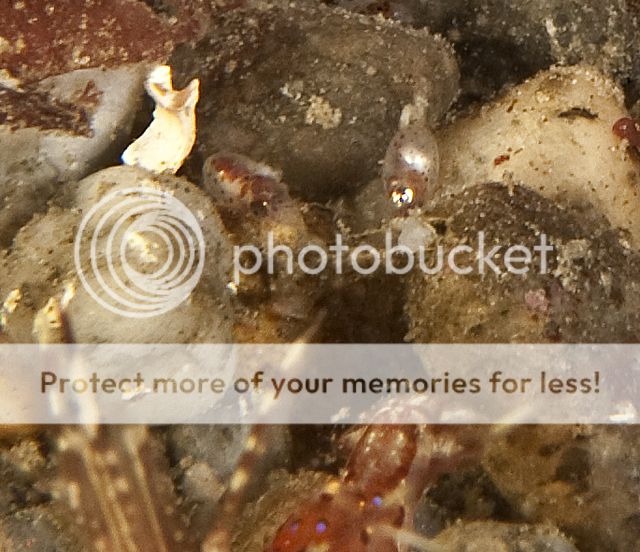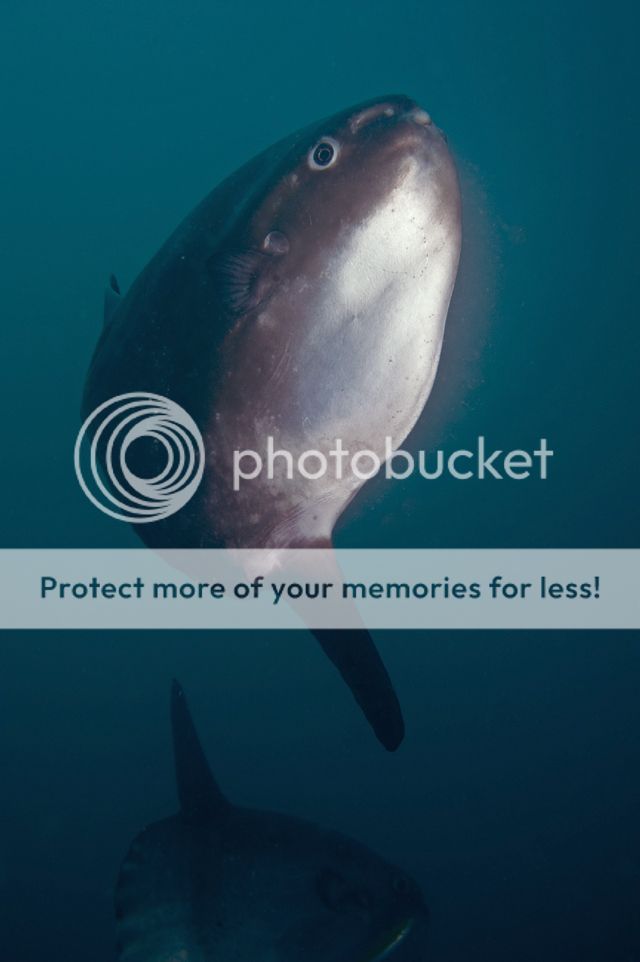Merry
Contributor
Last weekend, Phil and I were treated to 3 uncommon sights, all of which are included in this report.
We tend to think of our East Pacific red octopus, Octopus rubescens, as a shy slithering shape, blending with any relief it finds on the sandy bottom. However, the little octopus leads an even more tenuous existence in the planktonic stage before it settles and acquires its cryptic capabilities.
A withering mother octopus guards her festoons of pearly-white eggs, which are barely 4mm long. One study reports that she lays 80% of the eggs within 5 days. Only the mother octopus, a well-hidden den, and a thin chorion protect the developing embryo.

Empty chorions hang like corn husks - evidence that hatching has begun. Note the well-developed eyes and chromatophores.

When do they hatch?
Tough to say; the rate of embryonic development is dependent upon temperature and other factors. Best estimate based on lab studies at Moss Landing is 7 ½ - 13 weeks for this species. Because the egg sac is translucent, we’re able to see some structures as they appear during the 30 developmental stages.
The brick-red eyes in the first photo appear around stage 25. Three weeks after that photo was taken, Walter Marti caught the very beginning of the hatching period.
How do they hatch?
A transitory hatching gland (Hoyle’s organ) at the tip of the mantle enzymatically dissolves a portion of the chorion membrane. Combined with forceful movements of the mantle, arms and suckers, the hatchling squeezes out and heads into the water column for parts unknown.

Original drawing by Jordi Corbera, taken from Biology of the Planktonic Stages of Benthic Octopuses. Roger Villanueva & Mark D. Norman. Oceanography and Marine Biology: An Annual Review, 2008, 46, 105-202
The hatchlings, or paralarvae, are free-swimming, nearly transparent blobs. They seem ill-equipped to live completely exposed as part of the plankton. With poorly developed tentacles and few suckers, they receive nutrients from their remaining yolk sac until they can feed on tiny crustaceans.
Here are the hatchlings we saw from the nest shown above. But watch Walter Marti’s video Dirty Molas & Octo Babes at the Barge for a crisper look.


You can just make out the tiny tentacles here.


Should they survive the rigors of a planktonic lifestyle, settlement occurs, accompanied by important morphological changes. The juvenile octopus adopts a benthic existence with habits similar to those of adults.
Also nearby:
Metridium farcimen



Mola mola being cleaned is always exciting. This is all I could get with my portrait lens.



As if all this weren't enough, we then found a large moray eel on the crane at Haggerty's cove. I tried the calmest, most nonthreatening approach, but he wouldn't stick his head out for me.


We tend to think of our East Pacific red octopus, Octopus rubescens, as a shy slithering shape, blending with any relief it finds on the sandy bottom. However, the little octopus leads an even more tenuous existence in the planktonic stage before it settles and acquires its cryptic capabilities.
A withering mother octopus guards her festoons of pearly-white eggs, which are barely 4mm long. One study reports that she lays 80% of the eggs within 5 days. Only the mother octopus, a well-hidden den, and a thin chorion protect the developing embryo.

Empty chorions hang like corn husks - evidence that hatching has begun. Note the well-developed eyes and chromatophores.

When do they hatch?
Tough to say; the rate of embryonic development is dependent upon temperature and other factors. Best estimate based on lab studies at Moss Landing is 7 ½ - 13 weeks for this species. Because the egg sac is translucent, we’re able to see some structures as they appear during the 30 developmental stages.
The brick-red eyes in the first photo appear around stage 25. Three weeks after that photo was taken, Walter Marti caught the very beginning of the hatching period.
How do they hatch?
A transitory hatching gland (Hoyle’s organ) at the tip of the mantle enzymatically dissolves a portion of the chorion membrane. Combined with forceful movements of the mantle, arms and suckers, the hatchling squeezes out and heads into the water column for parts unknown.

Original drawing by Jordi Corbera, taken from Biology of the Planktonic Stages of Benthic Octopuses. Roger Villanueva & Mark D. Norman. Oceanography and Marine Biology: An Annual Review, 2008, 46, 105-202
The hatchlings, or paralarvae, are free-swimming, nearly transparent blobs. They seem ill-equipped to live completely exposed as part of the plankton. With poorly developed tentacles and few suckers, they receive nutrients from their remaining yolk sac until they can feed on tiny crustaceans.
Here are the hatchlings we saw from the nest shown above. But watch Walter Marti’s video Dirty Molas & Octo Babes at the Barge for a crisper look.


You can just make out the tiny tentacles here.


Should they survive the rigors of a planktonic lifestyle, settlement occurs, accompanied by important morphological changes. The juvenile octopus adopts a benthic existence with habits similar to those of adults.
Also nearby:
Metridium farcimen



Mola mola being cleaned is always exciting. This is all I could get with my portrait lens.



As if all this weren't enough, we then found a large moray eel on the crane at Haggerty's cove. I tried the calmest, most nonthreatening approach, but he wouldn't stick his head out for me.






